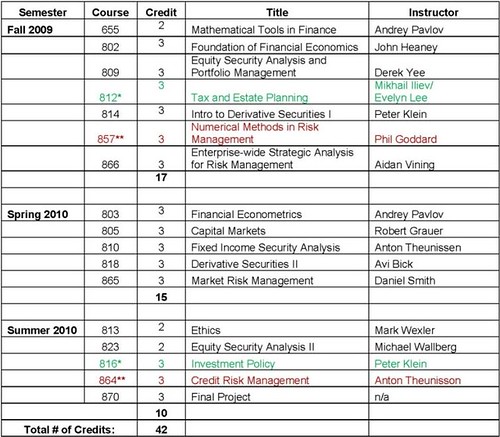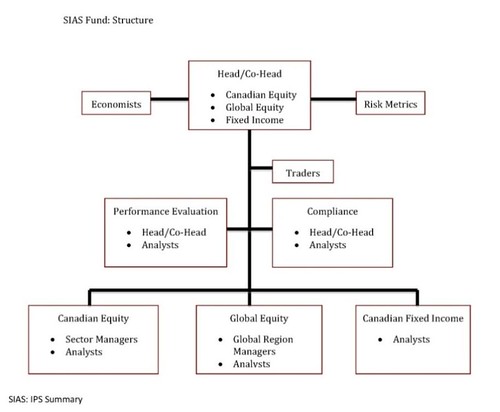Any of you who’ve been contemplating a graduate degree in finance will likely have something to take away from this interview. The degree in question is the 12 month Master of Financial Risk Management (MFRM) program at Simon Fraser University. Not only will you hear from a recent graduate about the different courses and the depth of knowledge that the MFRM course encompasses but you are most likely going to be hearing more from our interviewee in the future as he’s agreed to take the proverbial pen to paper and author a few guest article for Investing Thesis in the near future. So if have any questions or topics that you would like to learn more about after reading the interview, feel free to contact us and we’ll try our hardest make your dreams come true (if we can’t do that, at the very least we’ll try and get our interviewee to opine on a topic of your choosing).
Biography: Seyedreza (Reza) Ghafarianzadeh received a Master of Financial Risk Management (MFRM) degree form Simon Fraser University’s Segal Graduate School of Business in 2010 and a Bachelor of Financial Management degree from the University of Tehran in 2008. During the MFRM Program, Reza worked as a Research Associate for the Canadian Equity and Global Equity teams at the Student Investment Advisory Service (SIAS Fund), the largest student‐run endowment fund in Canada; with AUM of over $9.5M following a value investment philosophy. Reza began his career as a Financial Manager of Tehran Arisman Construction Company in 2005 and then as a part-time Commodity and FX Trader at Daria Extrusion Company in 2007.
Q: Reza, why don’t you tell us a little bit about your prior work experience and what led you to join SFU’s MFRM program?
A: Good question Arjun! I was admitted to the financial management program at the University of Tehran’s Faculty of Management, the top ranked business school in Iran in 2003. During my education there, I realized the need to get hands on experience in management principals, leadership, financial theories, accounting, strategic planning, marketing and trading. In 2005, I was introduced to Tehran Arisman Construction Company, a small Private joint Stock company, where I started my career as a Financial Manager. Over two years, I successfully managed a book of business consisting of 60 corporate clients by building solid relationships through regular communications while at the same time, negotiated with financial institutions to fund various projects. The job required me to work with Excel spread sheets for budgeting projects, ranking members and calculating surcharges. I developed my own group of integrated Excel spread sheet including Late Payment Surcharge Program and Member Ranking Program based on client’s payments and credits. In 2007, as a part-time job I worked as the international marketer and as a commodity and FX trader at Daria Extrusion Company. It was a good opportunity for me to put my trading skills in practice. I implemented the trading based on the need of the company for commodities and its need for hedging currency risk. At this point in my career, I already knew about working in a team, strategic planning, trading, financial management, financial markets and monetary system in Iran. I always wanted to focus my career on two fields; Risk and Equity analysis which I didn’t cover in my work experience and I knew I wanted to do my master in these two fields. After researching Master programs in the US and Canada, I came across the Master of Financial Risk Management Program at SFU and I was impressed by its curriculum and reputation. The MFRM vastly covers mathematics tools in finance, econometrics, capital markets, equity analysis, fixed income, credit risk management, derivatives, numerical methods and market risk. Due to its uniqueness and quantitative nature, I applied to the MFRM Program and fortunately got admitted. One of the biggest motivations was the student run portfolio at SFU’s Segal graduate school. It’s a voluntary opportunity for students to practice what they learn at school.
Q: Now that you’ve graduated from the program, give us your thoughts on the program and what you feel you’ve learnt from it? Is there anything that you feel could have been empathized more? What jobs/careers do you feel empowered to tackle now that you’ve completed the MFRM program? To whom would you recommend the program?
A: First, let me tell you a bit about the MFRM Program. It’s a 1 year accelerated program including 42 credits and 15 courses. We had more than 62 assignments and projects in one year. Most of them were realistic assignments from the real world.
• The Equity Security Course by Dr. Yee not only prepared us for financial analysis and financial modeling including DCM (DDM, FCFF, FCFE, and Residual Income) but also attribution and investment compliance.
• The Market Risk Course by Dr. Smith gave us comprehensive understanding of Basel I/II, Risk Modeling including Implied Volatility, ARCH, GARCH (p, q), RiskMetrics, and Historical simulation.
• The Derivative Courses by Dr. Bick and Dr. Klein gave us an understanding of the Derivatives world including Options, Forwards, Futures, swaps and others.
• Fixed Income Course by Dr. Theunissen introduced us to everything about bonds including duration and convexity of bonds and simulation of interest rates.
• Capital Market Course by Dr. Grauer emphasized on Market Risk and Return, and Portfolio Theories including CAPM, Factor Models, Fama French Three Factor Model, Efficient Market Hypothesis, Efficient Frontier and Growth Optimal Theory.
• Econometrics Course by Dr. Palvov taught us the Time-Series Regression, Cross-Sectional Regressions, OLS, GLS, and MLE.
I have to say the MFRM is a comprehensive quantitative program that would attract and prepare anyone who is passionate about Risk Management, Equity Analysis, Fixed Income Analysis, and Derivatives. A strong focus is given to stochastic calculus, deriving equations, MatLab programming, and Excel programming, including lots of modeling and simulations. I would recommend this program to professionals who have been in financial industry or students who have a solid quantitative finance background. The MFRM program also prepares students for all three levels of the CFA exam and for most of the courses, it goes far beyond the CFA curriculum.
Q: Part of the program involves managing over $9 million of the university’s endowment portfolio, also known as the Student Investment Advisory Service (SIAS Fund). In terms of experiences, what was it like? What was your role in the management of this fund? What did the role teach you?
A: Let me explain the structure of the fund first:
The Student Investment Advisory Service also known as the SIAS Fund is funded by contributions from HSBC Bank Canada and the Lohn Foundation. The SIAS Fund manages over $9 million of the university’s endowment portfolio. The fund follows a value investing mandate set by the client (SFU) through a conservative investment policy statement (IPS). It has four actively managed classes: Cash, Canadian Equity, Global Equity and Fixed Income. The fund reports monthly compliance and performance to the client and faculty advisors. In addition, performance review presentations are held on a quarterly basis (IPS and Structure included).
About my role at the SIAS Fund, I worked as a Research Associate in the Canadian Equity and Global Equity teams. It was pretty exciting! I was working with a team of Research Associates, Investment Management Associates, Economists, and Traders. I reported to the heads of Canadian Equity and Global Equity; undertook a full range of research and analysis focused on the performances of current holdings and potential investment opportunities, also investigated investment opportunities by completing detailed research reports including Canadian equity (The industrial Sector Outlook, DII.B, WJA, NXY) and European ETFs (including EWG, EWQ) and ensured data integrity of reports and analysis by supervising, assessing, and confirming the quantitative and qualitative valuations of other Research Associates (including MCD, TXN, CAT, MFST, SAP, Material Sector outlook, Canadian Oil Sands).
Reference: About SFU SIAS Fund (PDF)
Q: Given your extensive experience in trading and investment research, how would you describe your personal approach to investing/trading? Also how do you approach and control risk/volatility?
A: I consider myself a risk-averse value trader/investor with a long-term investment horizon. Personally, as a position trader, I would take long or short positions according to approved research reports on specific stocks. However, recently in an effort to expand my knowledge in investing/trading methods, I implemented a Pairs Trading strategy based on Implied Volatility in Canadian equities with significant positive returns for stocks based on S&P/TSX Composite.
Let me explain the Risk measures that I used. Implied Volatility represents the volatility built into the price of an option in the market. Implied volatility is particularly important because it determines market consensus about the expected volatility of the underlying stock in the future. Explicitly I can name the Montreal Implied Volatility Index (MVX) for Canadian equities (specially S&P/TSX Composite) and The Chicago Board Options Exchange Market Volatility Index (VIX) for US equities (especially for S&P 500). GARCH (p,q) can be considered as a good signal for trading. However, the GARCH model is not very stable and underestimates future volatility (Nelson, 1991) while the implied volatility is a forward-looking measurement of risk.
In pairs trading, I have two approaches:
Portfolio Rotation (Large Capital Portfolio/Small Capital Portfolio) based on size which uses Implied Volatility as a signal to switch between Large Capital Portfolio/Small Capital Portfolio. Many studies suggest that when risk in the market is low, small portfolios have a higher return than large portfolios, and vice versa. Small-cap returns are generally higher than large-cap. Fama and French (1992), and Copeland and Copeland (1999) show that the above is especially true when the volatility is low since volatility and market return are negatively correlated.
Portfolio Rotation (Growth Portfolio/Value Portfolio) based on Style which is using Implied Volatility as a signal to switch from my Value portfolios to Growth portfolios. If the estimate of expected future volatility increases, the strategy involves taking a long position in value portfolios and a short position in growth portfolios and vice versa when volatility decreases, because when the volatility is high, the predictability of future cash flow falls.
For controlling risk, I implemented different measures of risk including GARCH (p,q), Historical Simulation, RiskMetrics, and Beta of CAPM as a relative measure of Risk for specific stocks, but obviously risk measures depend on the IPS of the portfolio that the analyst works for.
Reference: Market Timing: Style (Value versus Growth) and Size Rotation Using The MVX by Seyedreza Ghafarianzadeh (PDF)
Thank You, Reza.









